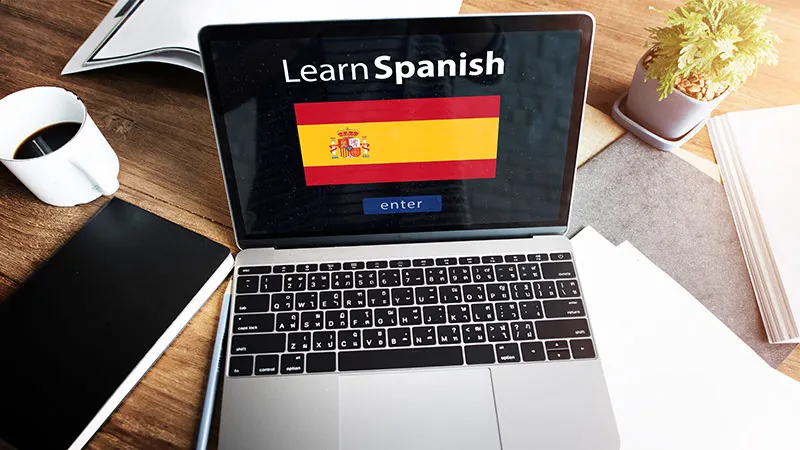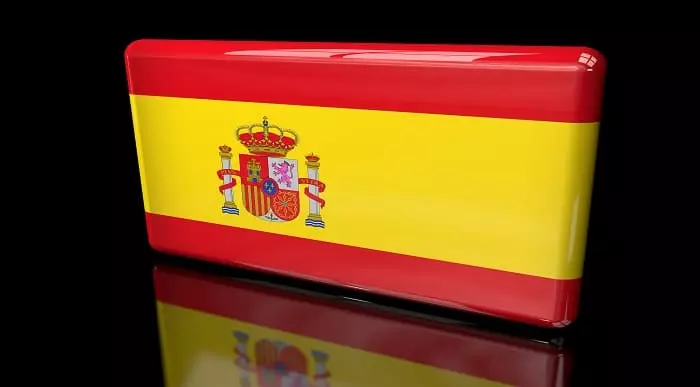Personal Development
10 Easiest Ways to Learn Spanish
Looking for 10 easiest ways to learn Spanish?
You may have decided to learn Spanish after encountering the language frequently in your day-to-day life or because you are going to travel, work or expand your business in one of the 20 countries around the world where Spanish is the official language. Whether it is for vacation, curiosity, or necessity, you can learn the language by following the 10 easiest ways suggested in this blog and overcome the language barrier.
As per The Mimic Method, “Spanish is spoken by over 570 million people across the world. Over 480 million of these are native Spanish speakers. Spanish is the official language or co-language of over 20 countries, including Argentina, El Salvador, Venezuela and Spain.”
“Currently, Spanish is the 3rd most commonly used language in the world. It comes after Mandarin Chinese and English. The language is also the second language used in International Communication”, as stated by Protranslate.
One of the significant advantages of knowing Spanish is that it would give you access to Spanish movies, series, music and, of course, LaLiga. All these forms of entertainment become even more enjoyable for those with the ability to understand and speak the language.
Whether it’s for a purpose or a means of spending your leisure, you can learn Spanish by yourself and expand your knowledge beyond ‘despacito’ and ‘taco!’
Table of Content
- How to Learn Spanish by Yourself in 10 Simple Steps?
- Tips That Can Help You Learn Spanish Faster
- Is it Hard to Learn Spanish?
- How to Understand People when they Speak Fast in Spanish?
- How To Get the Perfect Spanish Pronunciation?
- Mistakes To Avoid While Learning Spanish
- Topics that Need More Attention
- Conclusion
- What to Read Next:
How to Learn Spanish by Yourself in 10 Simple Steps?
You might have been planning to learn the Spanish language for a long time but did not show the courage to finally start off thinking that it would be tough. We have brought to you 10 easiest ways to make your job easier.
1. Set Realistic Goals
The first step towards learning Spanish has to be establishing specific short-term, mid-term and long-term goals. For example, make a goal that you will learn 5 new Spanish words every day and revise the 5 words that you have learned on the previous day. In this way, your goal would be specific, relevant and achievable.
The first step towards learning Spanish has to be establishing specific short-term, mid-term and long-term goals. For example, make a goal that you will learn 5 new Spanish words every day and revise the 5 words that you have learned on the previous day. In this way, your goal would be specific, relevant and achievable.
2. Listen to Podcasts
Podcasts can be an excellent source for learning Spanish, giving a structure to your learning. Whether you walk, drive or take the train, you can always download some Spanish-speaking podcasts to play on your way to school or work. You can make your “free time” productive along with learning a new language.
3. Learn through Movies and TV Shows
If you are a beginner, watch Spanish movies with English subtitles and if you are an advanced learner, watch Spanish movies with Spanish subtitles. By reading and listening at the same time, you would be able to improve your pronunciation. You might even develop an accent like the locals.
4. Learn through Recipes
This one might be particularly applicable for a food enthusiast who loves to eat and cook. If you are someone who often experiments with cooking and tries out different recipes, this can be an interesting way to learn Spanish and cook a new dish at the same time.
You can either read Spanish cookbooks or watch cooking shows and tutorials on YouTube. This would help you to have a grasp on the spice names and popular dishes. It will also introduce you to new cuisine and let you explore more about their culture.
5. Read in Spanish
It may be a little difficult to read in Spanish at the beginning because of your limited vocabulary. However, you can get children’s books or materials specially written for beginners.
If you can find an audio version of the text you are reading, that would be even better! This way, you can be clear about the pronunciations while you are listening to a native speaker pronounce.
Depending on your interests and level of Spanish, you might also want to read magazines like Cosmopolitan in Spanish or news on sites like BBC Mundo. In addition, keeping an eye on the news, magazines and articles will definitely enrich your vocabulary.
6. Communicate with Native Speakers
You shouldn’t be afraid or feel shy of speaking Spanish because you may make some mistakes. Find a person you feel comfortable with to practice and enhance your communication skills. If you have a friend or a neighbour who is a Spanish native speaker, try to speak to them daily, even if it’s just a few sentences. You can even ask them to correct your grammar mistakes or your pronunciation.
7. Take an Online Spanish Course
If there is no Spanish language study centre in your area, you can aim for learning online which is a highly effective method for learning Spanish. Since we carry our laptops, tablets and phones almost everywhere we go, any online course is now at our disposal anytime, anywhere.
Lead Academy offers accredited Spanish courses for beginners, intermediate and advanced learners. Here you can learn through high-quality e-learning study materials and ask for support 24/7.
8. Translate Often
Try translating into Spanish whatever you read or hear; whether it’s a Facebook post or a random song. It will make you more accustomed to the language and you can then understand which words you need to learn or work on. Once you build this habit, your mind will want to translate everything you see into Spanish.
9. Incorporate Spanish Into Your Lifestyle
Learning a language is not only about studying its grammar and vocabulary – it’s about immersing yourself in a whole new culture. So if you want to learn Spanish fast, you must stick out with everything related to this language as much as possible.
This includes everything from listening to Spanish music and radio stations, watching Spanish movies and telenovelas, reading about Spanish culture, to joining local Spanish societies and attending their events, having language exchanges and social activities with Spanish native speakers.
10. Stay Consistent
No matter which approach you choose to study Spanish and how difficult it seems, make a schedule and stick to it. Target to study for at least one hour a day and keep revising and practising. You will gradually see more progress doing it over an extended period of time rather than all at once.
Develop Your Team to Lead The Industry
Get fully accredited thousands of high quality online courses taught by the world’s leading experts suitable to companies of all sizes.
Tips That Can Help You Learn Spanish Faster
While there is hardly any shortcut to learning Spanish quickly, there are some tricks of the trade that you can follow. The specific tips can help boost your memory to learn the language at a faster rate.
1. Write it down
Writing things while listening can help you solidify learning because it engages a different part of your brain that controls the fine motor function involved in writing.
2. Create visual organisers
In addition to writing words while you’re learning Spanish, draw the related images next to the word. It gives your brain an extrasensory detail to remember and facilitates better recall.
3. Use mnemonics
A mnemonic is a tool that makes it easy to remember certain facts or large amounts of information in the form of a song, rhyme, acronym, image, phrase, or sentence. For instance, a mnemonic to remember the names of the days of the week in Spanish might be “Lucy Makes My Journeys Very Special Delights” (Lunes, Martes, Miércoles, Jueves, Viernes, Sábado, Domingo).
4. Master the basics
Grow your confidence by starting with some basic words to start building your Spanish word bank. You can start with the followings-
- Hola = Hello
- Adiós = Goodbye
- Por favor = Please
- Gracias = Thank you
- Lo siento = Sorry
- Sí = Yes
- No = No
Once you have grasped the words, dive into the conversational phrases that will help you ease into real-world conversations.
- Buenos días = Good morning
- Buenas tardes = Good afternoon
- Buenas noches = Good evening
- Mucho gusto = Nice to meet you
- ¿Cómo estás? = How are you?
- ¿Cómo te llamas? = What ‘s your name?
Is it Hard to Learn Spanish?
While it completely depends on a person’s aptitude, learning Spanish should be easier for a native English speaker due to the overlapping vocabulary of the two languages. Some of the similar words that exist in both the languages are-
| Spanish | English |
| Metal | Metal |
| Fórmula | Formula |
| Excursión | Excursion |
| Drama | Drama |
| Confusión | Confusion |
Top Courses of This Category
How to Understand People when they Speak Fast in Spanish?
It often gets difficult to understand the Spanish language when someone is speaking really fast. The less familiar you are with the words in a sentence, the faster it may seem.
This is not the case in Spanish only. Often in English, we don’t talk like we type or write. When saying a full sentence, we usually don’t say each word in the sentence the same way as we would have alone.
For example, “Hey, what’s up?” is often pronounced as “Hey, wassup?” by the natives when they speak fast. When people speak really fast, they combine words and drop syllables by necessity. There are some ways suggested for you to solve this issue which are as follows:
- Listen to Latin rap music. Like rappers in English, they drop a lot of syllables to get the words out so quickly, which can be ideal for you to practice deciphering the meaning of a sentence when said in speed.
- Practise reading faster and aloud. Try to copy the way Spanish speakers talk. With enough practice, you can easily reproduce similar to their speech rate and will get used to the way the language sounds.
- You do not need to catch every word you hear; instead, ponder upon main ideas. Get rid of the feeling that you should hear all words or else you would not understand the conversation.
- Follow Spanish vlogs that will make you interested in the content and you can stay updated. The daily dose of Spanish accent will make you accustomed to the language.
How To Get the Perfect Spanish Pronunciation?
You need to work a bit to get a grip over the Spanish pronunciation. You might struggle with the Spanish tongue because it requires a greater level of flexibility. However, you can try out the following to improve your pronunciation.
Adopt an Accent
The first step in improving your pronunciation is to pick a Spanish speaking country to decide which accent and dialect you want to focus on. This is because of the different Spanish accents; Argentina, Spain, Mexico, Cuba and all other Spanish speaking countries in the world speak their own version of Spanish.
Does Spain resonate with you because it is in Europe or Mexico due to the dominance of Mexican Spanish in the United States? Simply choose the one that works for you and stick with it.
Once you have decided, you need to be extra conscious about the word accents i.e. the little dashes written above a certain syllable in a Spanish word that might entirely alter the meaning of the word.
For example, the word for ‘father’ is written as ‘papá’ with the accent on the last letter meaning you should emphasise the last bit of the word more. When you miss the accent, you eventually pronounce the word ‘papa,’ which means ‘potato.’
Monitor Your ‘B’s and ‘V’s
You might have a problem pronouncing the Spanish ‘b’ and ‘v’. These two sounds are identical in Spanish.
To emit the perfect Spanish pronunciation of ‘v’, for a second, let your teeth rest on your bottom lip as if you are going to say the word ‘vest‘ and practice pairing this ‘v’ with the Spanish vowels of ‘a’, ‘e’, ‘i’, ‘o’ and ‘u’.
The Spanish ‘b’ is similar to the English ‘b’, as in ‘break’ and you may also practice pairing the Spanish ‘b’ with the language’s vowels.
Switchback and forth between these mouth positions when you pronounce words like ‘viento‘ (wind) and ‘bella‘ (pretty). If the two sounds sound similar, you are doing something right.
Learn to Link Words like the Locals
The Spaniards tend to occasionally link or blend words together when the last letter of a certain word matches the first letter of the following word. For instance, the phrase ‘dos sacos’ (two coats) would sound like ‘dosacos.’
Learning how to link words is one of the effective ways of improving your Spanish pronunciation. Developing an ear for linked words also improves your listening skills and better prepares you for linking and blending your words. This would help you to comprehend what Spanish speakers are saying when they blend words.
Mistakes To Avoid While Learning Spanish
Here are some of the common mistakes listed that English speakers often make when they are learning Spanish.
Assuming that Spanish Words that Look Like English Words Mean the Same Thing
Spanish and English share a large vocabulary derived from Latin, for which there are words that are alike in both languages and have similar meanings. However, there are plenty of exceptions as well. For example, “embarazada” means “pregnant” rather than “embarrassed,” and a “violador” usually is a rapist, not someone who has violated a law.
Translating Idioms Word for Word
As it is already known, the meanings of English idioms and phrases cannot readily be determined from the meanings of the individual words and Spanish is no exception to that. For example, “en el acto” is an idiom meaning “on the spot” rather than “in the act,” and “en efectivo” means “in cash” rather than “in effect.”
Following the English Sentence Order
Instead of following the English sentence order every time, pay attention to where the subject is placed after the verb in Spanish. Changing the word order can sometimes subtly change the meaning of a sentence. Also, like some English constructions, placing a preposition at the end of a sentence should not be followed in Spanish.
Using the Wrong Prepositions
Using the right preposition can be challenging. It can be helpful to think about the purpose of the prepositions rather than their translations. This will help you avoid mistakes such as using “pienso acerca de ti” (I’m thinking near you) instead of “pienso en ti” (I’m thinking about you).
Ignoring Proper Pronunciation
Spanish pronunciation can seem difficult at times, and that is why you need to be careful while trying to learn the sounds. The most common mistakes of beginners include making the ‘l’ of fútbol sound like the “ll” in “football,” making the ‘b’ and ‘v’ sound different from each other (the sounds are identical in Spanish) and failing to trill the r.
Besides, you can visit our other blogs, “How Long Does It Take to Learn BSL” and “How to Learn BSL? Beginner to Advanced.”
Using Pronouns Unnecessarily
Unlike English, the Spanish language does not frequently require a subject. While it usually depends on the context, the subject of a sentence (which in English often would be a pronoun) can and usually should be omitted. It wouldn’t be grammatically incorrect to include the pronoun, but it can sound clunky and be an overuse of the pronouns.
Topics that Need More Attention
Now that you are aware of the mistakes to be avoided, you should also be aware of certain aspects of Spanish grammar that would need some extra attention if you want to have full-fledged fluency in the language.
Gendered Words
For an English speaker, learning that nouns have a specific gender can be really daunting. While Casa is female, sofá is masculine. Once you remember which ones use which, you have to make sure that all the other adjectives surrounding the nouns agree. For instance, to say “the house is pretty and clean”, you must remember that the house is feminine; therefore, the adjectives also have to be feminine. So, the sentence would be- la casa es bonita y limpia.
Tenses
Trying to remember the correct vocabulary, making sure all your adjectives agree with your nouns and after that, choosing between pretérito indefinido and imperfecto may drive you baffled. However, you cannot skip this part and if you want to sound fluent and more like a native, the use of different tenses is something you have to learn.
Subjunctive
This might be one of the hardest things to get. After being bombarded with tons of new tenses, you get to know there’s a whole other dimension of tenses called the subjuntivo. It is used when you want to express a desire or a doubt when one action depends on another or following some fixed expressions with “que.” There are many uses of subjunctives and understanding them can be really difficult.
Conclusion
Learning a new language like Spanish is fun and challenging at the same time. Instead of worrying about the difficulties, focus on the good part. With Spanish fluency, you don’t need to look for the English subtitles while watching your favourite series like la casa de papel and you can easily understand the commentaries while watching LaLiga. If you completely devote yourself and make strenuous efforts, learning Spanish wouldn’t be a tough job at all!
What to Read Next:
- How old do you have to be to get a tattoo?
- How Do You Become a Professor – A Complete Guide to be a Professor
- Wonderful Sources of Support for Learning and Development
- Want to be a Teacher but Scared of Public Speaking? 10 Easy Tips
- Home Schooling UK – Law and Process
- How to Become a SEN Teaching Assistant
- Why Do You Want to Be a Teacher? Frequently Asked Interview Questions











